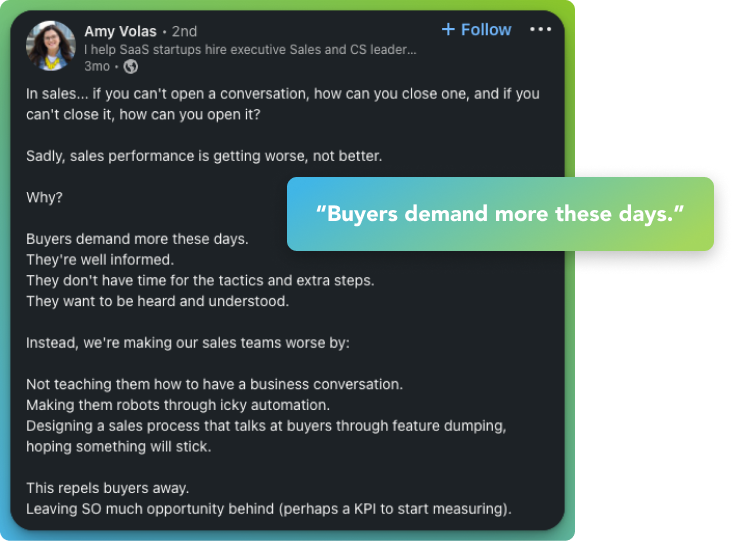Improving your sales performance isn’t about hustling harder or outworking everyone else. (For the record, hustle culture needs to die along with WeWork’s water cooler cucumbers.)

Going HAM on all of your accounts just doesn’t make sense. It’s basic math:
- If you spread your time equally across your opportunities, you’ll spin your wheels and waste time on deals that will never close no matter how hard you try.
- If you take a strategic approach and focus the bulk of your efforts on the accounts that have the highest probability of closing, you’ll improve your sales performance.
But how do you know which accounts are most likely to close? By understanding customer sentiment and engagement–a.k.a. the building blocks of customer pulse–and the role they play within a sales meeting:
Sentiment
The positive or negative emotion a customer displays
Engagement
The level of compromise and attention a customer displays.
The higher the sentiment and engagement on an account, the more likely the deal is to close.
Collectively, we call sentiment and engagement “emotional insights.”
Emotional insights are key to improving sales performance.
Harvard professor Gerald Zaltman says that 95% of purchasing decisions are subconscious. In other words, feelings lead people to buy. (If you’ve ever bought software, a sports car or a super-sized container of Ben & Jerry’s ice cream, you know firsthand that this is true.)
However, different feelings spark different reactions. Some of your customers might be sprinting toward gain while others might be sprinting away from pain. When you deeply understand your customers’ emotions and motivations, you can respond appropriately to get at-risk deals back on the table.
While customer emotions might feel “squishy,” there’s a science to it. There’s also a simple framework to help you uncover opportunity-level sentiment and engagement data.
Watch Webinar
Introducing the 2 x 2 customer sentiment and engagement matrix

Sales Interaction Agent by Uniphore analyzes language, tone and non-verbal cues across each video meeting to score deals based on your customers’ sentiment and engagement.
- On the Y axis is customer sentiment: positive or negative
- On the X axis is customer engagement: high or low
Within this 2 x 2 framework, there are four types of customers:

1. Champions
These are your positive-sentiment, high-engagement customers. Collectively, they are eager to participate in the sales process. They feel positively about your brand and product. These deals are most likely to close; and while you need to spend time on these accounts, they aren’t a heavy lift.

2. Distracted Champs
These are your positive-sentiment, low-engagement customers. Collectively, they are less eager to participate in the sales process, but they feel positively about your brand and product. These deals have a good chance of closing if you can get them engaged. This is where you should focus the majority of your efforts.

3. Challengers
These are your negative-sentiment, high-engagement customers. Collectively, they are eager to participate in the sales process. If they’re highly engaged, they care. They want to solve their problem, but there’s something missing. These deals have a fair chance of closing if you can avoid talking about features and instead pinpoint the one thing that could make them flip.

4. Cold Fish
These are your negative-sentiment, low-engagement customers. Collectively, they are less eager to participate in the sales process. They feel less positively about your brand and product. These deals have a low likelihood of closing, even with effort.
Uncover your Distracted Champs.
Know where to spend the bulk of your efforts to improve your sales performance.
(no email required)
How to improve engagement in your Distracted Champs
Distracted Champs may be open to buying, but the problem you solve is not a “hair on fire” problem. Or, they may have other problems competing for their attention. Or, they might be torn between vendors. Or, the decision maker isn’t “in the tent.” Whatever the reason, you have a good chance of winning the deal if you can improve engagement.
Get more buyers to attend future sales calls.
The more people who attend the sales call on the buyer’s side, the better. Studies show that win rates increase the more buyers you get in the virtual room.
Hone your emotional intelligence.
Once you have all the right buyers in the room, win them over by being emotionally intelligent. (Emotional intelligence is a prerequisite for consultative selling.)
Many skills people associate with good salesmanship stem from emotional intelligence (EQ). Work to build competency in all four pillars of EQ:
Self-Awareness
Self-awareness is the ability to recognize your own strengths and weakness and the effect your emotions have on others. According to the Harvard Business Review, 95% of people think they are self aware; however, only 10 to 15% truly are. Without assistance, that gap can seriously impact seller performance—particularly in virtual interactions.
Self-Management
We demonstrate self-management when we think before acting and express emotions with restraint. Self-management allows us to respond—rather than react–to situations based on information rather than impulse. The better information we have, the better we’re able to hold ourselves accountable for our decisions and actions.
Social Awareness
Social awareness is the ability to recognize others’ emotions and how they influence their behavior. It’s how we “read the room” in interactions. Those with high social awareness also demonstrate a high degree of empathy—the no. 1 leadership skill according to DDI, with empathetic leaders performing more than 40% higher in engaging others.
Relationship Management
Relationship management involves using emotional insights and leadership to foster positive relationships. It’s how we build trust and encourage repeat engagement. Not surprisingly, the most successful relationship managers are those with naturally high—or highly assisted—emotional intelligence.
Share new research and insights to flesh out the problem
Sales reps are experts in the solution space, but they don’t always do enough to convince buyers they deeply understand the problem space. Skimming over the problem and jumping to the solution reduces reps’ ability to show empathy. (Empathy is the foundation of modern consultative selling.)
As sales pro Amy Volas says,

Content can help reps better understand the problems buyers face–and show empathy:
- Did a research firm launch a new report that digs into your customer’s problem?
- Did your company conduct research and publish a research report?
- Did you hear a podcast episode that is relevant to your buyer?
- Did you host a webinar featuring successful customers?
Reach out to your Distracted Champ to share helpful content. Connect the dots between the insights, their problem, and possible solutions to show them you understand.
Download the 2 x 2 template and try it out.
If you’re not a Q For Sales customer, you can still get value from mapping customer sentiment and engagement.
This 2 x 2 template includes 10 questions to help you determine the sentiment and engagement of each account. This exercise is so simple, you could even do it on a napkin.
Note: Completing the 2 x 2 by hand will provide a less accurate state of the union on deals (similar to entering sales activity data manually vs. automatically capturing sales activity data). By contrast, Sales Interaction Agent has analyzed thousands of hours of sales conversations, and uses multimodal AI to determine customer sentiment and engagement.
